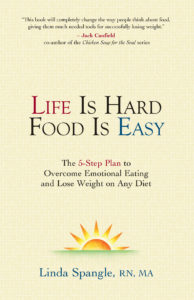
What’s going on?
In this chapter, you’ll learn about how I discovered the two types of emotional eating needs: Head hunger and Heart hunger.
Here’s an excerpt from the chapter.
Many years ago, I worked in a challenging job as a hospital health educator. During that time, nearly every afternoon I would get an intense craving for a cookie.
So on my break, I’d walk to a nearby bakery and buy a couple of chewy oatmeal raisin cookies.
It bothered me that I couldn’t break this habit. But no matter how hard I tried to resist, those cookies would occupy my thoughts until I got out to the bakery for my “fix.”
One afternoon when work had been particularly stressful, I noticed I was practically gnashing my teeth as I bit into the chewy cookie. Suddenly it hit me that what I really wanted to chew on was my obnoxious boss and the hospital’s administrative staff.
After that, I began paying attention to how I felt when I ate certain foods and I discovered some interesting connections. I noticed that when I felt stressed or frustrated, I looked for “chewy” foods such as cookies or candy bars.
But when I was struggling with sadness or grief, I preferred soft ones like ice cream or my own homemade macaroni casseroles.
Food is a mirror
I realized that food choices often act as a mirror, showing exactly which emotions are prompting our desire to eat. Not knowing what we want also points toward specific emotional needs.
For example, when fighting stress, anger or frustration, people typically reached for foods that were chewy or crunchy. They really wanted to “chew” on something in life, such as their employers, their children, or even projects or deadlines.
Because this pressure-related eating seemed to be generated by specific thoughts or attitudes, I labeled it head hunger.
Other times, my clients would describe eating to cope with hollow or restless feelings like boredom, depression or loneliness. When experiencing these “empty” emotions, they typically chose soft, creamy-textured foods or “comfort foods” such as ice cream, pasta, or chocolate.
Since this type of eating seemed connected to the “lack” of things, such as love or attention, I labeled it heart hunger.
Labeling gives you power!
When you’re trying to stop emotional eating, labeling gives you power! Instead of slapping your head and exclaiming, “Why did I eat that?” you’ll be able to quickly figure out what sent you toward a food fix.
Here’s an example of how it might look in your own life. Suppose it’s the middle of the afternoon and you still haven’t finished the difficult report that’s due at five o’clock.
Suddenly you feel like eating something—one of those nut-filled candy bars from the vending machine sounds great. You trudge down the hall, get the candy bar, and eat half of it before you return to your desk.
Because your eating was connected to pressure emotions such as stress and deadlines, I would label this “head hunger.”
Later that evening you flip through the channels on TV, but nothing looks interesting. You’re exhausted from work and you wish you weren’t living alone. You wander around the house thinking about eating something, but you can’t decide what you want.
Eventually, you peek into the refrigerator to see if anything looks good. Finally you pull the half-empty carton of caramel fudge ice cream out of the freezer and take a few bites.
It tastes nice—kind of soothing. So you take the it with you as you stroll back to the couch. This time, your eating was related to empty emotions of fatigue, boredom and loneliness, so I label it “heart hunger.”
With practice, you can learn how to easily distinguish between these two types of emotional eating. Once you identify what’s driving your desire to eat, you can take care of what you really need, instead of burying your emotions with a plate of brownies or a bag of potato chips.
These food-emotion connections may not always work for you. Sometimes you won’t be able to identify any emotional issues that appear related to your eating. But keep searching. Eventually, the connection between food and your emotions will become more obvious.
Knowing what’s prompting your eating desire gives you a much greater chance of doing something that will address your real need and keep you out of the cupboard.
Or, if you’ve already eaten something, you can look backward and figure out what contributed to your eating and how you could prevent that situation in the future.
 Today: Read Chapter 3 in Life is Hard, Food is Easy
Today: Read Chapter 3 in Life is Hard, Food is Easy
You can write answers for this week’s questions in your notebook or journal, or download the worksheet below for your answers.
Click here for the Chapter 3 Worksheet.
Assignment: Identify which emotional need you are having:
head hunger and heart hunger
1. What are your most common head hunger times? Which foods are you likely to want most when you have pressure emotions that indicate head hunger?
2. Build an “instead list” for head hunger times? What are you best tools for dealing with stress, anger, frustration, irritation or other pressure emotions?
3. What are your most common heart hunger times? Which foods are you likely to want most when you have empty emotions that indicate heart hunger?
4. Build an “instead list” for heart hunger times? What are you best tools for dealing with sadness, loneliness, depression, restlessness, hurt or disappointment?
5. This week—whenever you experience food cravings or non-hungry eating thoughts, make a quick diagnosis to determine whether they’re related to head hunger or heart hunger. Write your answers in your notebook or journal.
Then wait at least ten minutes before you eat. During that time, do three items from your list of “insteads.” Write down what you did and how it worked for you.
Read my answers here: (From blog posts for 100 days of Weight Loss)
Head hunger insteads
Heart hunger insteads